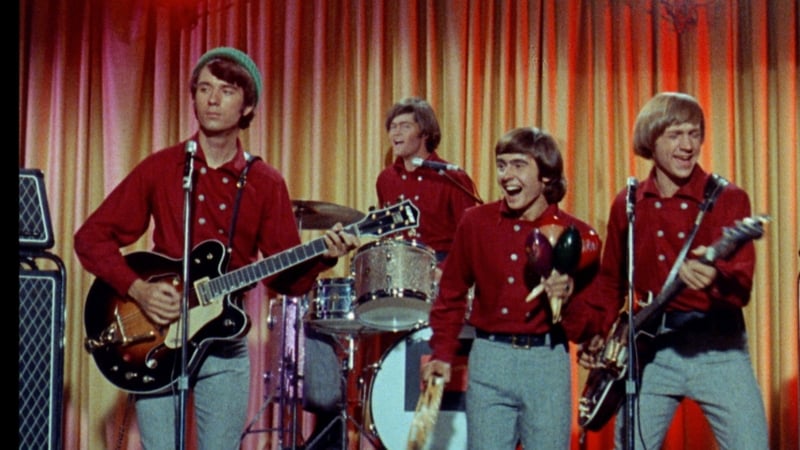Meeting the Beatles
Critics of the Monkees observed that they were simply the "
Pre-Fab four", a made-for-TV knockoff of
the Beatles; however, the members of the Beatles themselves took it in their stride and even hosted a party for the Monkees when they visited England. The party occurred during the time when the Beatles were recording album
Sgt. Pepper's Lonely Hearts Club Band; as such, the party inspired the line in the Monkees' tune "
Randy Scouse Git", written by Dolenz, which read, "the four kings of
EMI are sitting stately on the floor."
George Harrison praised their self-produced musical attempts, saying, "It's obvious what's happening, there's talent there. They're doing a TV show, it's a difficult chore and I wouldn't be in their shoes for the world. When they get it all sorted out, they might turn out to be the best."
[32] (Monkees member Peter Tork was later one of the musicians on Harrison's album
Wonderwall Music, playing
Paul McCartney's five-string
banjo.
Nesmith attended the Beatles session recording for single "
A Day in the Life" at Abbey Road Studios; he can be seen in the Beatles' home movies, including one scene where he is talking with
John Lennon. During the conversation, Nesmith had reportedly asked Lennon "Do you think we're a cheap imitation of the Beatles, your movies and your records?" to which Lennon assuredly replied, "I think you're the greatest comic talent since the
Marx Brothers. I've never missed one of your programs."
[32] Nesmith wrote about this encounter on
Facebook:
When the Beatles were recording Sgt. Peppers, Phyllis and I spent a few days with John and wife
Cynthia Lennon at their home, and one in the studio with "the boys." That's where those pictures of John and I come from—the "Day in the Life" session. The minute I had the wherewithal—cachet and money—I raced to London and looked up John.
During the '60s it seemed to me London was the center of the World and the Beatles were the center of London and the Sgt Pepper session was the center of the Beatles. It was an extraordinary time, I thought, and I wanted to get as close as I could to the heart of it. But like a hurricane the center was not stormy or tumultuous. It was exciting, but it was calm, and to an extent peaceful. The confidence of the art permeated the atmosphere. Serene—and really, really fun. Then I discovered the reason for this. During that time in one of our longer, more reflective, talks I realized that John was not aware of who the Beatles were. Of course he could not be. He was clueless in this regard. He had never seen or experienced them. In the strange paradox of fame, none of the Beatles ever saw the Beatles the way we did. Certainly not the way I did. I loved them beyond my ability to express it. As the years passed and I met more and more exceptional people sitting in the center of their own hurricane I saw they all shared this same sensibility. None of them could actually know the force of their own work.
Dolenz was also in the studio during a
Sgt. Pepper session, which he mentioned while broadcasting for radio
WCBS-FM in New York (incidentally, he interviewed
Ringo Starr on his program). On February 21, 1967, he attended the overdub and mixing session for the Beatles' "
Fixing a Hole" at EMI's Abbey Road studio 2.
[122]
During the 1970s, during Lennon's infamous "lost weekend", Lennon, Ringo Starr, Micky Dolenz,
Harry Nilsson and
Keith Moon often hung out together, and were collectively known in the press as "
The Hollywood Vampires".
[123]
Paul McCartney can be seen in the 2002 concert film
Back in the U.S. singing "Hey, Hey, We're The Monkees", the theme from
The Monkees television show, while backstage.
The Monkees "Cuddly Toy" and "Daddy's Song" were written by songwriter
Harry Nilsson. "Cuddly Toy" would be recorded several months before Nilsson's own debut in October 1967.
[44] At the press conference announcing the formation of Apple, the Beatles named Nilsson as both their favorite American artist and as their favorite American group. Derek Taylor, the Beatles' press officer, had introduced them to Nilsson's music.
[124]
In 1995, Ringo Starr joined Davy, Peter and Micky to film a
Pizza Hut commercial.
[125]
Julian Lennon was a fan, stating at the time of Davy Jones' passing, "You did some great work!"



